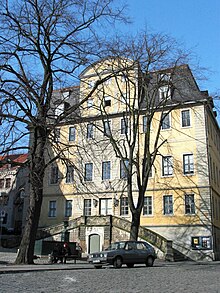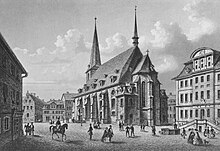Wilhelm-Ernst-Gymnasium Weimar
The Wilhelm-Ernst-Gymnasium at Herderplatz 14 in Weimar was founded in 1712 by Duke Wilhelm Ernst and is the oldest school building in the city. Here u. a. the writers Johann Gottfried Herder , Johann Heinrich Voss , Friedrich Wilhelm Riemer and Johann Karl August Musäus school lessons. The old grammar school is designated as a single monument and one of the few preserved secular buildings from the pre-classical period in Weimar. It is in a prominent urban development location in the old town and, as one of three Weimar Herder sites , it is part of the “ Classic Weimar ” ensemble , which was declared a World Heritage Site by UNESCO in 1998 .
history
The Wilhelm-Ernst-Gymnasium was founded in 1712 at the behest of Duke Wilhelm Ernst of Saxony-Weimar instead of the old town and country school from 1561 as a new ducal school for the gifted under the name "Wilhelminum Ernestinum" . The teachers here included Johann Heinrich Voss , Friedrich Wilhelm Riemer and Johann Karl August Musäus . After several years of school use, General Superintendent Johann Gottfried Herder, who had been appointed to Weimar, took over the directorate of the grammar school in 1776 and, as Ephorus , was also given overall supervision over all schools in the Duchy of Saxony-Weimar-Eisenach . From 1784 onwards, Grand Duke Karl August von Sachsen-Weimar-Eisenach left the ballroom to the Reformed community for worship. Around 1800 the school received a school library that had been lacking for a long time (parts of it came to the Weimar City Archives around 1950). In the 19th century the building continued to serve as a humanistic grammar school . On October 10, 1887, increasing numbers of pupils led to the move to a larger new school building at Amalienstraße 4 in Weimar (since September 1991 the Goethe Gymnasium Weimar ). The old building on Herderplatz served as the Grand Ducal Saxon Building Trade School from 1910 . The Wilhelm-Ernst-Gymnasium was only referred to as such until 1945. In 1953, a museum for natural history was set up in the former grammar school in the GDR . The building also included the “Polytechnic Center” of the Weimar schools with teaching classes and production rooms.
Building
The baroque-style school building , which still bears the inscription “ Soli deo gloria ” (Latin for “Only God for Glory”), was built between 1712 and 1716 right next to the town church of St. Peter and Paul under the direction of master builder Christian Richter built. It is a three-storey building with a high, extended mansard roof and a small roof house. The facade is emphasized by a three-axis central projection, which is crowned by a two-storey dwelling . In front of the facade there is a sweeping, two - flight flight of stairs that dominates the entire forecourt. A staircase is built on the north side like a risalit, through which the floors are accessed. The originally probably stone staircase was replaced by a wooden staircase in 1860. In 1976 the once spacious foyer , which connected the ground floor with the upper floor, was closed in favor of an additional classroom and a massive staircase core was installed as a steel construction with concrete block steps. The building has six large classrooms and a hall on the ground floor and first floor, the stucco ceiling of which has largely been preserved. The teacher's apartments were once housed on the second floor and the attic. A few double-leaf doors and windows of the original doors and windows are still preserved, the rest were replaced at a later time. During the GDR era, a politically influenced mural made of painted tiles was installed in the entrance area.
Herderbrunnen
In front of the stone staircase of the Wilhelm-Ernst-Gymnasium, in the direction of Herderplatz, there has been an octagonal, cast-iron fountain since 1832 based on the design of the architect and senior building director Clemens Wenzeslaus Coudray , which was appropriately named "Herderbrunnen" for the location. Its parts were cast in a Franconian iron foundry near Coburg . Its appearance is similar to the first cast iron fountain in Weimar, the "Goethe fountain", which was set up on the Frauenplan in 1822 (see: Fountain in Weimar ). Here, too, the inlet into the fountain can be seen above an obelisk with a crowning crater . The gargoyle has the shape of a devil's face. A stylized snake adorns one of the plates of the fountain in the middle. The edges of the panels, on the other hand, are each bordered by a continuous meander band . The base, the heel stones and the dog trough are made of travertine in contrast to the cast iron basin .
Todays use
The premises of the building, now also known as the “Altes Gymnasium Weimar” , was used after 1990 by the non-commercial local radio “ Lotte ” (until 2008) and by the neighboring Weimar Adult Education Center, the latter still using it today. The UNESCO ensemble “ Classic Weimar ” from the former grammar school, the Herderhaus and the city church of St. Peter and Paul, known as the “ Herder Church ”, was restored with 5.4 million euros from the Federal Government's “National UNESCO World Heritage Site Investment Program” . No agreement has yet been reached for the subsequent use. In January 2010 the Friends of the Goethe National Museum suggested the idea of setting up a “Herder Museum” in the former school building to commemorate the work of the poet, translator, philosopher and theologian at the place where he worked.
Directors
Senior directors and vice-directors of the grammar school (sorted by term of office):
- Johann Matthias Gesner (1691–1761), classical philologist and librarian - vice rector from 1715 to 1729
- Jakob Carpov (1699–1768), philosopher, theologian and mathematician, rector from 1737, director from 1745 to 1768
- Johann Michael Heinze (1717–1790), philologist, rector
- Johann Friedrich Hirt (1719–1783), Protestant theologian, orientalist, philosopher - Vice Rector from 1748 to 1758
- Johann Gottfried Herder (1744–1803), poet, translator, theologian, philosopher etc. - director from 1776 to 1791
- Karl August Böttiger (1760–1835), philologist, archaeological writer - director from 1791 to 1806
- August Gotthilf Gernhard (1771–1845), philologist - director from 1819 to 1845
- Johann Friedrich Röhr (1777–1848), theologian, writer, Goethe's oratory - Ephorus from 1820
- Hermann Sauppe (1809–1893), classical philologist, pedagogue and epigraphist - director from 1845 to 1856
- Gustav Weiland , director from 1856 to 1860
- Hermann Rassow (1819–1907), Graecist and Aristotle researcher - director from 1860 to 1881
- Hugo Ilberg (1828–1883), respected grammar school teacher - vice rector from 1861 to 1862
- Ludwig Less (1841–1926), director from 1881 to 1908
- Paul Koetschau (1857–1939), director from 1908 to 1923
- Carl Theil (1886–1945), director from 1923 to 1924
- Emil Herfurth (1887–1951), director from 1932 to 1945, politician (DNVP, NSDAP)
Teacher
Sorted by apprenticeship period
- Johann Karl August Musäus (1735–1787), writer, philologist, collector of fairy tales - from 1769 professor of ancient languages and history
- Johann Traugott Leberecht Danz (1769–1851), church historian and theologian - teacher until 1798
- Heinrich Voß (1779–1822), classical philologist - from 1804 to 1806 professor of Latin and Greek
- Franz Passow (1786–1833), classical philologist - from 1807 to 1810 professor of Greek
- Ferdinand Gotthelf Hand (1786–1851), classical philologist - from 1810 professor of philosophy and Greek literature
- Johannes Schulze (1786–1869), Prussian theologian, philologist, educator and cultural officer - from 1808 to 1812 professor
- Friedrich Wilhelm Riemer (1774–1845), philologist, writer, librarian, Goethe's secretary - professor from 1812 to 1821
- Heinrich Graefe (1802–1868), pedagogue - spiritual teacher at the grammar school
- Christian Gottlob Tröbst (1811–1888), theologian, philosopher and mathematician - from 1847 professor
- Otto Apelt (1845–1932), classical philologist and translator - from 1869 to 1898 senior teacher or professor
- Hermann Rassow (1819–1907), classical philologist, director 1860–1881, high school councilor in the Grand Duchy of Saxony-Weimar-Eisenach
- Rudolf Quantity (1845–1912), classical philologist and teacher - from 1867 to 1876 teacher at the grammar school
Students and graduates
Well-known high school students and graduates (sorted by year of birth):
- Johann Andreas Pörtzel (1736–1821), pastor, later superintendent and senior pastor in Blankenhain (Thuringia)
- August Wilhelm Hupel (1737–1819), Baltic German pastor, man of letters
- Friedrich Justin Bertuch (1747–1822), publisher and patron
- Johann Gottlob Bernstein (1747–1835), doctor, professor of medicine
- Johann Gottfried Hasse (1759–1806), theologian and orientalist
- August von Kotzebue (1761–1819), playwright and writer, Russian Consul General - high school diploma in 1777
- Christian August Vulpius (1762–1827), writer, librarian, Goethe's brother-in-law
- Johann Christoph Gottlob Weise , German botanist and author
- Carl Leberecht Schwabe (1778–1851), Mayor of Weimar, Saxon-Weimar Court Councilor
- Gottlob König (1779–1849), forest scientist - pupil from 1790 to 1794
- Karl Benedikt Hase (Karl Benedikt Hase) (1780–1864), Graecist, palaeographer, professor and librarian
- Wilhelm Martin Leberecht de Wette (1780–1849), theologian
- Hieronymus Müller (1785–1861), philologist and translator
- Johann Gottlob Töpfer (1791–1870), organist and composer - student from 1804 to 1808
- Karl Wilhelm Göttling (1793–1869), classical philologist
- Emil Huschke (1797–1858), anatomist, zoologist and embryologist - pupil from 1811
- Johann Christian Lobe (1797–1881), composer and music theorist - student from 1804 to 1811
- Constantin Ackermann (1799–1877), general superintendent in Meiningen
- Friedrich Bernhard Vermehren (1802–1871), Judge of Appeal in Jena
- Ernst Eduard Ludwig Wedel (1804–1877), Grand Ducal Saxon personal physician and general practitioner in Jena - student from 1817
- Heinrich Aemilius August Danz (1806–1881), legal scholar - pupil from 1820
- Carl Zeiß (1816–1888), mechanic and entrepreneur (optics) - pupil until 1832
- Karl Eckermann (1834-1891), landscape painter
- Alfred Götze (1865–1948), prehistorian, museum director - pupil from 1875 to 1886
- Hans Zenker (1870–1932), Admiral of the Imperial Navy, Chief of Naval Management - student until 1889
- Hermann Jöck (1873–1925), member of the Landtag of the Free State of Saxony-Weimar-Eisenach
- Hans Wahl (1885–1949), Goethe researcher, museum and archive director - pupil from 1894
- Georg Haar (1887–1945), founder and notary - student from 1897 to 1906
- Felix Raabe (1900–1996), conductor and musicologist - Abitur in 1919
- Othmar Jauernig (1927–2014), legal scholar
See also
- List of the oldest schools in the German-speaking area
- List of old-language high schools
- List of high schools in Thuringia
literature
- Walter, Karl: Herders Typus Lectionum for the Wilhelm-Ernst Gymnasium in Weimar . Hof-Buchdruckerei, 1905.
- Walter, Karl: Herder and Heinze: from the history of the Weimar high school . BG Teubner, Leipzig 1908.
- Francke, Otto: History of the Wilhelm-Ernst-Gymnasium in Weimar . H. Böhlau, Weimar 1916.
- Dempe, Hellmuth: The Wilhelm-Ernst-Gymnasium in Weimar around 1820 and his Ephorus Johann Friedrich Röhr . Dietrich Pfaehler, Bad Neustadt 1982.
Web links
- Information on the history of the school on the website of the Goethe-Gymnasium Weimar
- Website “Investment Program National UNESCO World Heritage Sites” for the renovation of the grammar school
- The German Foundation for Monument Protection via the Wilhelm-Ernst-Gymnasium
- Press release "Where Herder taught" from the German Foundation for Monument Protection from October 16, 2006
- Website of the renovating architecture office of the old grammar school
- Photo of the south elevation of the grammar school in the scientific picture archive
- Article “Weimar should have a Herder Museum by 2017” in FOCUS from Jan. 31, 2010
- Article "First steps towards the establishment of a Herder Center in Weimar" in the magazine AugenBlick from April 15, 2010 (PDF)
- Article "No museum in the Wilhelm-Ernst-Gymnasium" in the Thuringian regional newspaper from May 19, 2010
Coordinates: 50 ° 58 ′ 53 ″ N , 11 ° 19 ′ 47.2 ″ E



